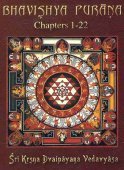Mahapurna, Mahāpūrṇa: 5 definitions
Introduction:
Mahapurna means something in Hinduism, Sanskrit. If you want to know the exact meaning, history, etymology or English translation of this term then check out the descriptions on this page. Add your comment or reference to a book if you want to contribute to this summary article.
In Hinduism
Vaishnavism (Vaishava dharma)
Source: Brill: Śaivism and the Tantric Traditions (vaishnavism)Mahāpūrṇa (महापूर्ण) or Periya Nampi refers to one of the Teachers mentioned in the guruparaṃparā of Vedānta Deśika’s Yatirājasaptati.—The poem’s first ten verses create the context for the exaltation of Rāmānuja. This context is the lineage of teachers (guruparaṃparā) who preceded him and are listed in the first eight verses of the poem in the following order: Nārāyaṇa, Śrī-Lakṣmī, Viṣvaksena, Nammāḻvār, Puṇḍarīkākṣa (Uyyaṅkoṇṭār), Śrīrāmamiśra (Maṇakkāl Nampi), Yāmuna (Āḷavantār) and Mahāpūrṇa (Periya Nampi). In verse 11 Rāmānuja is addressed, for the first time, with the phrase “Lord of the Ascetics” (patiṃ yatīnām).

Vaishnava (वैष्णव, vaiṣṇava) or vaishnavism (vaiṣṇavism) represents a tradition of Hinduism worshipping Vishnu as the supreme Lord. Similar to the Shaktism and Shaivism traditions, Vaishnavism also developed as an individual movement, famous for its exposition of the dashavatara (‘ten avatars of Vishnu’).
Languages of India and abroad
Sanskrit dictionary
Source: Cologne Digital Sanskrit Dictionaries: Edgerton Buddhist Hybrid Sanskrit DictionaryMahāpūrṇa (महापूर्ण).—name of a garuḍa prince: Saddharmapuṇḍarīka 5.5.
Source: Cologne Digital Sanskrit Dictionaries: Monier-Williams Sanskrit-English DictionaryMahāpūrṇa (महापूर्ण):—[=mahā-pūrṇa] [from mahā > mah] m. Name of a king of the Garuḍas, [Buddhist literature]
[Sanskrit to German]
Sanskrit, also spelled संस्कृतम् (saṃskṛtam), is an ancient language of India commonly seen as the grandmother of the Indo-European language family (even English!). Closely allied with Prakrit and Pali, Sanskrit is more exhaustive in both grammar and terms and has the most extensive collection of literature in the world, greatly surpassing its sister-languages Greek and Latin.
See also (Relevant definitions)
Query error!
Full-text: Pundarikaksha, Periya Nampi, Dhriti, Uyyankontar, Nammalvar, Shrilakshmi, Alavantar, Narayana, Yamuna, Shriramamishra, Manakkal Nampi, Ramanuja, Vishvaksena.
Relevant text
Search found 6 books and stories containing Mahapurna, Maha-purna, Mahā-pūrṇa, Mahāpūrṇa; (plurals include: Mahapurnas, purnas, pūrṇas, Mahāpūrṇas). You can also click to the full overview containing English textual excerpts. Below are direct links for the most relevant articles:
A History of Indian Philosophy Volume 3 (by Surendranath Dasgupta)
Part 2 - Rāmānuja < [Chapter XVIII - An Historical and Literary Survey of the Viśiṣṭādvaita School of Thought]
Yāmuna (Introduction) < [Chapter XIX - The Philosophy of Yāmunācārya]
Part 1 - The Aḻagiyas from Nāthamuni to Rāmānuja < [Chapter XVIII - An Historical and Literary Survey of the Viśiṣṭādvaita School of Thought]
Shat-cakra-nirupana (the six bodily centres) (by Arthur Avalon)
Verse 49 < [Section 7]
Lotus Sutra (by Tsugunari Kubo)
Lotus Sutra (Saddharma-Pundarika) (by H. Kern)
A History of Indian Philosophy Volume 5 (by Surendranath Dasgupta)
Part 1 - History and Literature of Vīra-śaivism < [Chapter XXXV - Vīra-śaivism]
A Dictionary Of Chinese Buddhist Terms (by William Edward Soothill)
Related products
